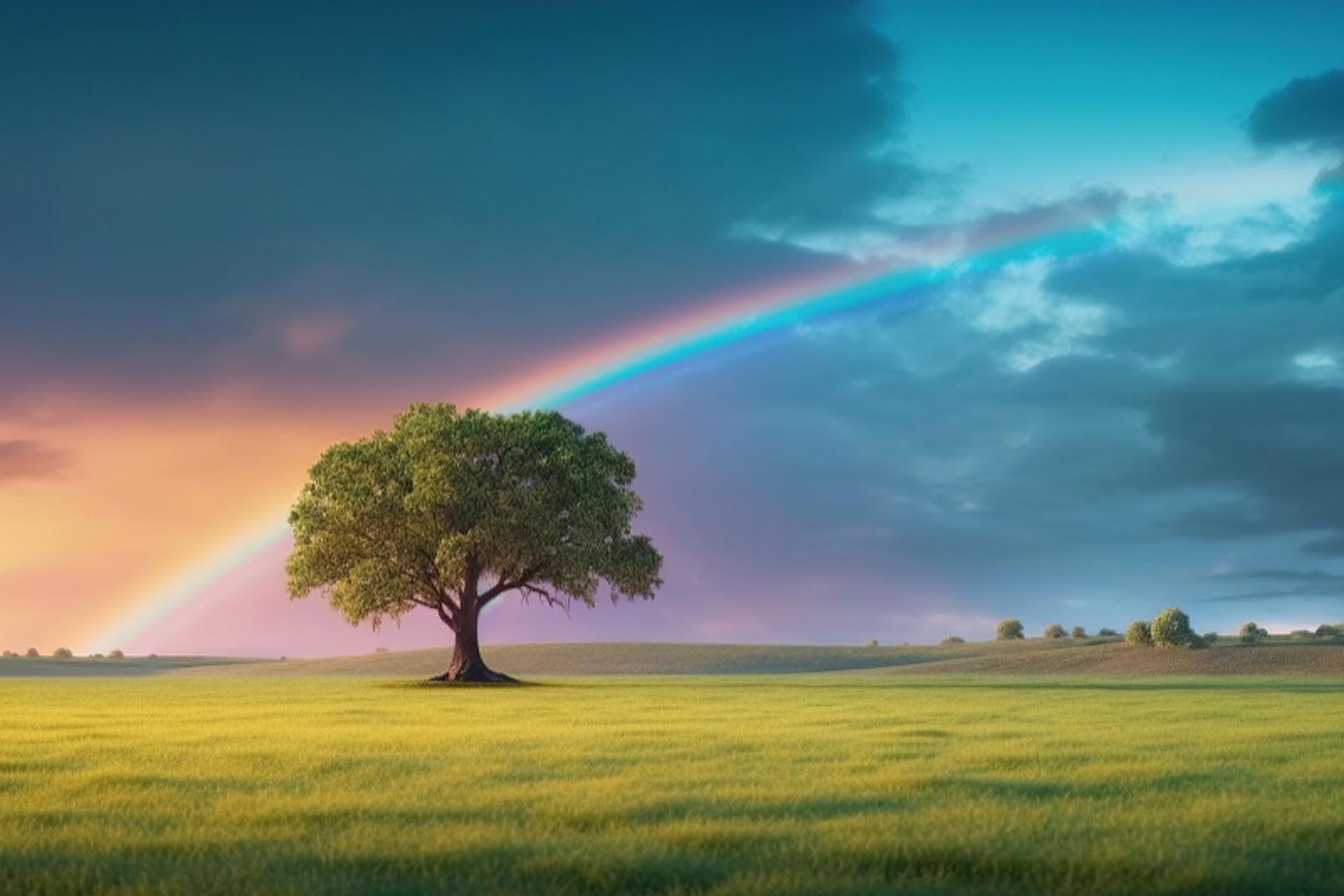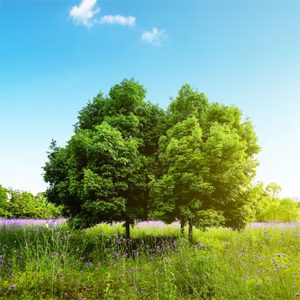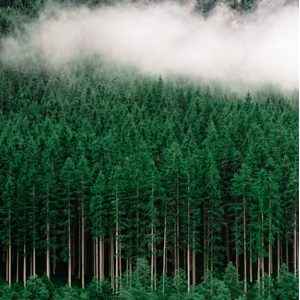
Choosing a tree for your yard starts with understanding the different tree types and their benefits. Let’s start with the basics. The classification of trees begins with two basic categories: deciduous and coniferous.
Deciduous trees are also called hardwoods. The leaves of various shapes burst into beautiful colors in autumn and fall to the ground. Examples include oak, elm, maple, and willow. In summer, they shade the house, and in winter, they shed their leaves and filter sunlight through their bare branches. Some deciduous trees, such as birch and crape myrtle, have peeling bark that provide beautiful winter focal points. Other deciduous trees bear berries and fruit.
Most conifers are evergreen, so they have greenery all year round. The leaves are needle-like and are found on pine, fir, spruce, and cedar. Evergreen trees not only shade the house in the summer, but also act as a windbreak to block the bitter winds in the winter. Conifers provide year-round privacy hedges to block out unwanted views. Birds and small animals can also find shelter in the evergreens, especially during the winter months.
 Consider climate and weather patterns
Consider climate and weather patterns
Different trees thrive in different climate zones, so even if you find one that offers the benefits you want, it may not grow well in your yard. Planting trees native to your area is always a good idea. There are many different types of trees to choose from. However, with global climate change, it is essential to select trees that can withstand the climatic conditions your area Clarence is expected to face in the next 30 to 50 years.
Think about size and space
When researching the different tree types in your yard, consider the available space. Your tree may look small now, but imagine what it will look like when it grows and how much space it will need. You wouldn’t want your tree to outgrow the space. The roots of certaintrees spread widely, and if you’re not careful, the roots can damage drains and foundations, block windows, and do more harm than good. So, you need to choose the right size tree for each specific area that has room to grow.
Soil quality assessment
Different types of trees require different types of soil, but one thing is certain. Poor soil means that the tree does not provide enough nutrients to survive. If you’re unsure of the soil quality in your yard, find Tree Soldiers nearest you for help.
Determine the purpose of the tree
What type of tree would you like to plant? fallen leaves? evergreen? Are you looking for a tree that can provide shade to help cool your home in the summer or provide a shady outdoor shelter? Do you want your children to have strong limbs so they can climb trees or build tree houses? What about trees that bear fruit? Or, you may want something that will add beauty, elegance and charm to your property. Knowing your expectations will help you narrow down your tree choices.
Consider the tree’s growth rate
Depending on the type of tree, climatic conditions and soil, each tree grows at a different rate. Even trees on the same lot can grow differently depending on their location. In general, there are slow-growing trees, medium-growing trees, and fast-growing trees.
Here are some examples of tree growth rates.
Rapid growth: Typically grows 25 inches or more annually.
Moderate growth: 13 to 24 inches per year.
Slow growth: About 12 or less per year.
Choose a disease resistance option
Some trees are more resistant to infection than others. Disease resistance helps maintain the appearance of your landscape by minimizing damage and helping save trees. When you find the type of tree that suits your needs, check its resistance to disease. This will help you make an informed decision when choosing which trees are most likely to thrive.
Consider maintenance requirements
Before making a final decision on which tree you want, find out how much maintenance it will require. Some trees, especially some fruit trees, require more maintenance than others. Make sure your tree can provide the care it needs to thrive.
Think of the shape of a tree
Here are a few things to look for when considering the shape of your tree.
Leaves – Broad or flat, large or small?
Bark – Does it peel or flake like birch?
Shape – Is the bottom wide or narrow?
Canopy Size – Is it wide (covering a large area) or small and narrow?
Flowering – Does it flower or bear fruit often?
Research local tree laws and regulations
Before planting a tree, it is a good idea to research the laws and regulations regarding trees in your area. If your place of residence has an HOA, check the HOA rules for trees you can and cannot plant in your yard.
Consult an expert
With so many tree types to choose from, finding the right tree for your yard can be a challenge. In the end, it’s a big decision. Once the tree has taken root and started to grow, it can be difficult to get rid of. Therefore, choosing the wrong tree can cause significant stress. For expert advice on choosing the right tree for your yard, contact the experts at Tree Soldiers location Clarence near you.
 Plant the perfect tree in your yard today!
Plant the perfect tree in your yard today!
Adding trees to your home can improve your home’s curb appeal, provide cool shade in the summer, and provide delicious fruit the whole family can enjoy. However, choosing the right tree for your needs and circumstances will determine how well your tree will grow. Our team of local experts can help you decide which tree is best for your yard. In addition to helping, you choose the right tree, we offer a range of landscaping and lawn care services to keep your property in top condition. This work is supported by the Tree Soldiers and your satisfaction is guaranteed. Call (716) 320-7799 or contact us for a free quote today

 Consider climate and weather patterns
Consider climate and weather patterns
 Plant the perfect tree in your yard today!
Plant the perfect tree in your yard today!
binance
October 20, 2024Can you be more specific about the content of your article? After reading it, I still have some doubts. Hope you can help me.
Crea una cuenta gratis
November 26, 2024I don’t think the title of your article matches the content lol. Just kidding, mainly because I had some doubts after reading the article.
skapa ett binance-konto
November 28, 2024Can you be more specific about the content of your article? After reading it, I still have some doubts. Hope you can help me.
M mt tài khon binance
January 3, 2025Thank you for your sharing. I am worried that I lack creative ideas. It is your article that makes me full of hope. Thank you. But, I have a question, can you help me?
binance
March 5, 2025Your article helped me a lot, is there any more related content? Thanks! https://www.binance.info/en-IN/register?ref=UM6SMJM3
binance code
April 20, 2025Thank you for your sharing. I am worried that I lack creative ideas. It is your article that makes me full of hope. Thank you. But, I have a question, can you help me?
sign up for binance
April 28, 2025I don’t think the title of your article matches the content lol. Just kidding, mainly because I had some doubts after reading the article.
OliveCoest
May 1, 2025купить аккаунт с прокачкой заработок на аккаунтах
Peterlip
May 1, 2025купить аккаунт с прокачкой магазин аккаунтов
RichardGap
May 1, 2025продать аккаунт https://magazin-akkauntov-online.ru/
Jamesrainy
May 1, 2025продажа аккаунтов маркетплейс для реселлеров
OliveCoest
May 2, 2025купить аккаунт с прокачкой маркетплейс аккаунтов
BryantDenia
May 2, 2025магазин аккаунтов социальных сетей https://kupit-akkaunt-top.ru/
RichardGap
May 2, 2025маркетплейс аккаунтов https://pokupka-akkauntov-online.ru
Davidexcib
May 3, 2025Website for Selling Accounts Secure Account Purchasing Platform
JasonTwinc
May 3, 2025Sell Account Account marketplace
MichaelAccum
May 3, 2025Ready-Made Accounts for Sale Account Trading Service
JaredSax
May 3, 2025Account Selling Platform Accounts marketplace
Brianren
May 3, 2025Purchase Ready-Made Accounts Account Buying Platform
Ronaldlow
May 3, 2025Account Exchange Service Accounts for Sale
Thomasgrife
May 3, 2025Account Trading Sell Pre-made Account
Brucejug
May 4, 2025Buy Pre-made Account Account Market
WilliamBaist
May 4, 2025Account Catalog Find Accounts for Sale
Ronaldlow
May 4, 2025Website for Buying Accounts Marketplace for Ready-Made Accounts
BrandonPar
May 4, 2025sell accounts account catalog
EdmundWhene
May 4, 2025buy and sell accounts verified accounts for sale
Romeofus
May 4, 2025account marketplace guaranteed accounts
KeithAerom
May 5, 2025accounts for sale sell pre-made account
Robertsiz
May 5, 2025database of accounts for sale https://buycheapaccounts.com/
HectorDen
May 5, 2025marketplace for ready-made accounts https://socialaccountsdeal.com/
Carloscoigo
May 5, 2025accounts market account catalog
RichardSaw
May 6, 2025accounts market buy pre-made account
Carlosurirm
May 6, 2025gaming account marketplace accounts-marketplace.org
Stephenprier
May 6, 2025find accounts for sale sell accounts
Stevendinna
May 6, 2025accounts marketplace purchase ready-made accounts
ClydeSwilD
May 6, 2025account purchase account selling service
JohnnyPoste
May 6, 2025account purchase buy pre-made account
Thomasced
May 6, 2025purchase ready-made accounts guaranteed accounts
PhilipMeafe
May 7, 2025account trading service marketplace for ready-made accounts
Randalgep
May 7, 2025account selling service account marketplace
Richardkisse
May 7, 2025website for buying accounts account sale
ZacharyStign
May 7, 2025sell accounts buy account
KevinDoubs
May 7, 2025buy pre-made account accounts for sale
Raymondwrosy
May 7, 2025accounts marketplace gaming account marketplace
ThomasLon
May 8, 2025account sale marketplace for ready-made accounts
Nathanclazy
May 8, 2025ready-made accounts for sale account market
BruceHox
May 8, 2025social media account marketplace online account store
Danieldaype
May 8, 2025account selling service sell pre-made account
Jasonabsef
May 8, 2025account marketplace account trading platform
Geraldrax
May 8, 2025account trading account exchange service
ThomasRhito
May 8, 2025secure account sales buy pre-made account
accounts-offer.org_tum
May 9, 2025online account store https://accounts-offer.org
accounts-marketplace.xyz_tum
May 9, 2025sell accounts https://accounts-marketplace.xyz
buy-best-accounts.org_tum
May 9, 2025secure account purchasing platform https://buy-best-accounts.org/
social-accounts-marketplaces.live_tum
May 10, 2025online account store https://social-accounts-marketplaces.live/
accounts-marketplace.live_Ingef
May 10, 2025buy account https://accounts-marketplace.live
social-accounts-marketplace.xyz_Ingef
May 10, 2025secure account purchasing platform accounts market
buy-accounts.space_Ingef
May 10, 2025sell account account market
buy-accounts-shop.pro_Ingef
May 10, 2025accounts for sale https://buy-accounts-shop.pro/
social-accounts-marketplace.live_tum
May 10, 2025secure account purchasing platform https://social-accounts-marketplace.live
buy-accounts.live_Ingef
May 10, 2025ready-made accounts for sale https://buy-accounts.live
accounts-marketplace.online_Ingef
May 11, 2025account market https://accounts-marketplace.online
accounts-marketplace-best.pro_tum
May 11, 2025account trading service https://accounts-marketplace-best.pro
akkaunty-na-prodazhu.pro_Ingef
May 12, 2025продажа аккаунтов https://akkaunty-na-prodazhu.pro/
rynok-akkauntov.top_Ingef
May 12, 2025магазин аккаунтов https://rynok-akkauntov.top/
kupit-akkaunt.xyz_Ingef
May 12, 2025продать аккаунт https://kupit-akkaunt.xyz
akkaunt-magazin.online_Ingef
May 12, 2025маркетплейс аккаунтов https://akkaunt-magazin.online/
akkaunty-market.live_Ingef
May 12, 2025маркетплейс аккаунтов соцсетей akkaunty-market.live
kupit-akkaunty-market.xyz_Ingef
May 12, 2025магазин аккаунтов магазины аккаунтов
akkaunty-optom.live_Ingef
May 13, 2025магазин аккаунтов https://akkaunty-optom.live
online-akkaunty-magazin.xyz_Ingef
May 13, 2025продажа аккаунтов online-akkaunty-magazin.xyz
akkaunty-dlya-prodazhi.pro_Ingef
May 13, 2025продажа аккаунтов https://akkaunty-dlya-prodazhi.pro
kupit-akkaunt.online_Ingef
May 14, 2025маркетплейс аккаунтов https://kupit-akkaunt.online/
buy-adsaccounts.work_Ingef
May 15, 2025facebook accounts for sale https://buy-adsaccounts.work/
buy-ad-accounts.click_Ingef
May 15, 2025buy fb account https://buy-ad-accounts.click
buy-ad-account.top_Ingef
May 16, 2025facebook ad accounts for sale buy facebook profile
buy-ads-account.click_Ingef
May 16, 2025buy facebook advertising https://buy-ads-account.click
ad-account-buy.top_Ingef
May 16, 2025fb account for sale https://ad-account-buy.top
binance pierakstīsanās bonuss
May 16, 2025Can you be more specific about the content of your article? After reading it, I still have some doubts. Hope you can help me. https://accounts.binance.com/da-DK/register-person?ref=V2H9AFPY
buy-ads-account.work_Ingef
May 16, 2025buy facebook ad account https://buy-ads-account.work
ad-account-for-sale.top_Ingef
May 16, 2025facebook ad accounts for sale buy facebook ad account
buy-ad-account.click_Ingef
May 17, 2025buy facebook old accounts https://buy-ad-account.click
Ralphtrarl
May 17, 2025Эта обзорная заметка содержит ключевые моменты и факты по актуальным вопросам. Она поможет читателям быстро ориентироваться в теме и узнать о самых важных аспектах сегодня. Получите краткий курс по современной информации и оставайтесь в курсе событий!
Углубиться в тему – https://medalkoblog.ru/
ad-accounts-for-sale.work_Ingef
May 17, 2025facebook account buy https://ad-accounts-for-sale.work
buy-ads-account.top_Ingef
May 17, 2025google ads account buy https://buy-ads-account.top/
buy-ads-accounts.click_Ingef
May 17, 2025buy google ads account https://buy-ads-accounts.click/
buy-ad-account.click_Ingef
May 17, 2025buy facebook ads manager https://buy-accounts.click
ads-account-for-sale.top_Ingef
May 18, 2025buy google adwords account google ads reseller
ads-account-buy.work_Ingef
May 18, 2025buy google ads sell google ads account
buy-ads-invoice-account.top_Ingef
May 18, 2025google ads accounts for sale buy google ads
buy-account-ads.work_Ingef
May 18, 2025buy google ads threshold accounts https://buy-account-ads.work
buy-ads-agency-account.top_Ingef
May 18, 2025google ads account seller https://buy-ads-agency-account.top
sell-ads-account.click_Ingef
May 18, 2025buy google ads verified account sell-ads-account.click
ads-agency-account-buy.click_Ingef
May 19, 2025google ads accounts for sale https://ads-agency-account-buy.click
buy-business-manager.org_Ingef
May 19, 2025buy facebook business manager account buy-business-manager.org
buy-verified-ads-account.work_Ingef
May 19, 2025buy google ads https://buy-verified-ads-account.work
buy-bm-account.org_Ingef
May 19, 2025business manager for sale buy facebook verified business account
buy-business-manager-acc.org_Ingef
May 19, 2025buy fb business manager https://buy-business-manager-acc.org
buy-verified-business-manager-account.org_Ingef
May 20, 2025facebook business manager buy buy business manager
buy-verified-business-manager.org_Ingef
May 20, 2025facebook bm for sale https://buy-verified-business-manager.org/
business-manager-for-sale.org_Ingef
May 20, 2025buy business manager buy verified business manager facebook
buy-business-manager-verified.org_Ingef
May 20, 2025buy business manager account https://buy-business-manager-verified.org/
buy-bm.org_Ingef
May 20, 2025facebook bm buy https://buy-bm.org
verified-business-manager-for-sale.org_Ingef
May 21, 2025buy facebook business manager https://verified-business-manager-for-sale.org
buy-business-manager-accounts.org_Ingef
May 21, 2025buy verified bm facebook buy-business-manager-accounts.org
buy-tiktok-ads-account.org_Ingef
May 21, 2025buy tiktok business account https://buy-tiktok-ads-account.org
tiktok-ads-account-buy.org_Ingef
May 21, 2025tiktok ads account for sale https://tiktok-ads-account-buy.org
tiktok-ads-account-for-sale.org_Ingef
May 21, 2025tiktok agency account for sale https://tiktok-ads-account-for-sale.org
tiktok-agency-account-for-sale.org_Ingef
May 21, 2025tiktok ads account for sale https://tiktok-agency-account-for-sale.org
buy-tiktok-ad-account.org_Ingef
May 21, 2025buy tiktok ads https://buy-tiktok-ad-account.org
buy-tiktok-ads-accounts.org_Ingef
May 22, 2025tiktok ad accounts https://buy-tiktok-ads-accounts.org
buy-tiktok-ads.org_Ingef
May 22, 2025buy tiktok ads accounts https://buy-tiktok-ads.org
buy-tiktok-business-account.org_Ingef
May 22, 2025buy tiktok ads accounts tiktok ads agency account
tiktok-ads-agency-account.org_Ingef
May 22, 2025tiktok ad accounts buy tiktok ads
binance registration
June 29, 2025Thanks for sharing. I read many of your blog posts, cool, your blog is very good.
binance
June 29, 2025Can you be more specific about the content of your article? After reading it, I still have some doubts. Hope you can help me.
accounts_Ingef
July 12, 2025buy aged facebook ads account account trading service account market
accounts_Ingef
July 13, 2025buy ad account facebook account catalog account market
免费Binance账户
July 17, 2025Your point of view caught my eye and was very interesting. Thanks. I have a question for you.
Create a free account
August 19, 2025Your point of view caught my eye and was very interesting. Thanks. I have a question for you. https://www.binance.info/ru-UA/register?ref=OMM3XK51
"oppna ett binance-konto
August 22, 2025Can you be more specific about the content of your article? After reading it, I still have some doubts. Hope you can help me. https://www.binance.info/en/register?ref=JHQQKNKN
^Inregistrare Binance US
September 30, 2025Thanks for sharing. I read many of your blog posts, cool, your blog is very good.
binance帳戶創建
October 1, 2025Thanks for sharing. I read many of your blog posts, cool, your blog is very good.
binance Registro
October 7, 2025Thanks for sharing. I read many of your blog posts, cool, your blog is very good.
binance
October 9, 2025I don’t think the title of your article matches the content lol. Just kidding, mainly because I had some doubts after reading the article.
binance
October 12, 2025I don’t think the title of your article matches the content lol. Just kidding, mainly because I had some doubts after reading the article.
Davidbix
October 13, 2025Этот информационный обзор станет отличным путеводителем по актуальным темам, объединяющим важные факты и мнения экспертов. Мы исследуем ключевые идеи и представляем их в доступной форме для более глубокого понимания. Читайте, чтобы оставаться в курсе событий!
Узнать больше – https://vivod-iz-zapoya-1.ru/
binance sign up bonus
October 14, 2025Thank you for your sharing. I am worried that I lack creative ideas. It is your article that makes me full of hope. Thank you. But, I have a question, can you help me?
Bonus d'inscription à Binance
October 24, 2025I don’t think the title of your article matches the content lol. Just kidding, mainly because I had some doubts after reading the article.
Immediate Olux
November 13, 2025Immediate Olux se demarque comme une plateforme d’investissement crypto revolutionnaire, qui exploite la puissance de l’intelligence artificielle pour fournir a ses clients des avantages concurrentiels decisifs.
Son IA scrute les marches en temps reel, detecte les occasions interessantes et execute des strategies complexes avec une precision et une vitesse inaccessibles aux traders humains, maximisant ainsi les potentiels de profit.
Clarte Nexive Review
November 14, 2025Clarte Nexive se distingue comme une plateforme de placement crypto revolutionnaire, qui exploite la puissance de l’intelligence artificielle pour fournir a ses clients des atouts competitifs majeurs.
Son IA analyse les marches en temps reel, identifie les opportunites et execute des strategies complexes avec une precision et une vitesse inaccessibles aux traders humains, augmentant de ce fait les perspectives de gain.
TurkPaydexHub Review
November 15, 2025TurkPaydexHub Trading
TurkPaydexHub se differencie comme une plateforme de placement crypto innovante, qui utilise la puissance de l’intelligence artificielle pour fournir a ses clients des atouts competitifs majeurs.
Son IA scrute les marches en temps reel, detecte les occasions interessantes et applique des tactiques complexes avec une finesse et une celerite inatteignables pour les traders humains, maximisant ainsi les perspectives de gain.
binance referral
December 21, 2025Your point of view caught my eye and was very interesting. Thanks. I have a question for you. https://www.binance.info/register?ref=IHJUI7TF
Buat akun gratis
January 7, 2026I don’t think the title of your article matches the content lol. Just kidding, mainly because I had some doubts after reading the article.